How Many Calories Do You Burn Rock Climbing? (2024 Guide)
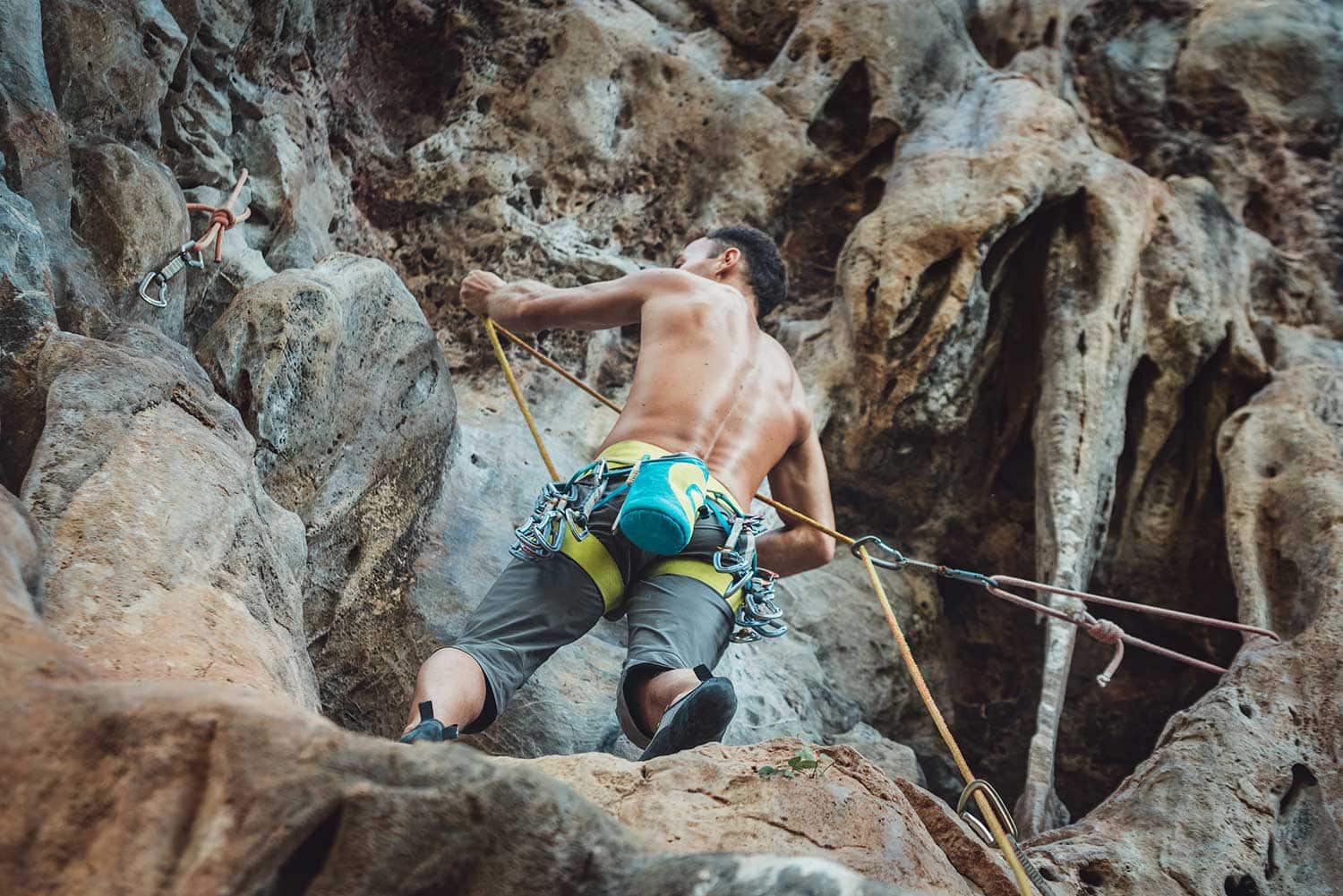
Published on: 05/24/2022
Rock climbing is an activity that come with many benefits. As a physical sport, it engages the muscles of your entire body. A single climbing session can provide you with an intense full-body workout, depending on the duration and difficulty level of the route. You may be surprised that rock climbing can burn more calories than you think.
The question is, how many calories can rock climbing burn? Let’s explore the science behind calories, calorie deficits, and the fitness and exercise implications of rock climbing.
Weight Loss 101

What’s a Calorie?
A calorie measures the energy you put into your body with food and drinks. You need energy to live, work, and function. Your body stores the energy you consume and then burns or breaks it down when you need it.
There are two types of calories, small and large. A small calorie, also called a gram calorie, is measured by the amount of heat needed to raise the temperature of one gram of water from 14.5 degrees Celsius to 15.5 degrees Celcius. A large calorie is called a ‘Calorie’ with a capital C. This type of calorie is a nutritional or dietary calorie equal to 1,000 small calories. Large Calories are what you see marked on food labels.
Your caloric needs are unique to you. You can use a basal metabolic rate (BSM) to measure how many calories you need. A Basal Metabolic rate indicates the smallest number of calories required for your body to function at rest.
How Many Calories Should I Eat?
According to the National Institute of Health, research suggests that a middle-aged person who is moderately active should consume around 2,000 calories daily for a female and 2,500 calories for a male. Consuming less than 1,500 calories for men or 1,200 for women can put you at risk of not getting enough nutrients or energy required by the body.
According to the McKinley Health Center, each food has a standard calorie count. For example, carbohydrates and proteins have about four calories per gram. Fats have about nine calories per gram.

The kind of calories you eat makes a difference. A good diet consists of a combination of carbohydrates, fat, and protein. Foods like avocados, quinoa, dried fruit, nuts, and whole grains are good as they are high-calorie and nutrient-dense. Spinach, celery, corn, and leafy greens are also good, despite being low-calorie foods, because they are full of vitamins and fiber. It is best to steer clear of any foods with empty calories like pizza, ice cream, soda, or candy. These foods can be filling temporarily but have minimal benefits or nutrition.
Calorie Deficit
While our bodies need a minimum number of calories to function, many people choose a calorie deficit to lose weight. A calorie deficit means eating and drinking less than your body burns. The more calories you consume compared to your daily caloric needs, the more likely you’ll gain or maintain your weight. When you consume fewer calories than you burn, you achieve a calorie deficit and lose weight.
Your diet and level of activity combined help you achieve a calorie deficit. Focus on smaller portions of fruits and vegetables, proteins, whole grains, and nutrient-dense foods. You can also control your calorie intake by creating a meal plan and adding moderate to intense physical activity into your daily routine.
How Do I Calculate the Number of Calories I Burn?
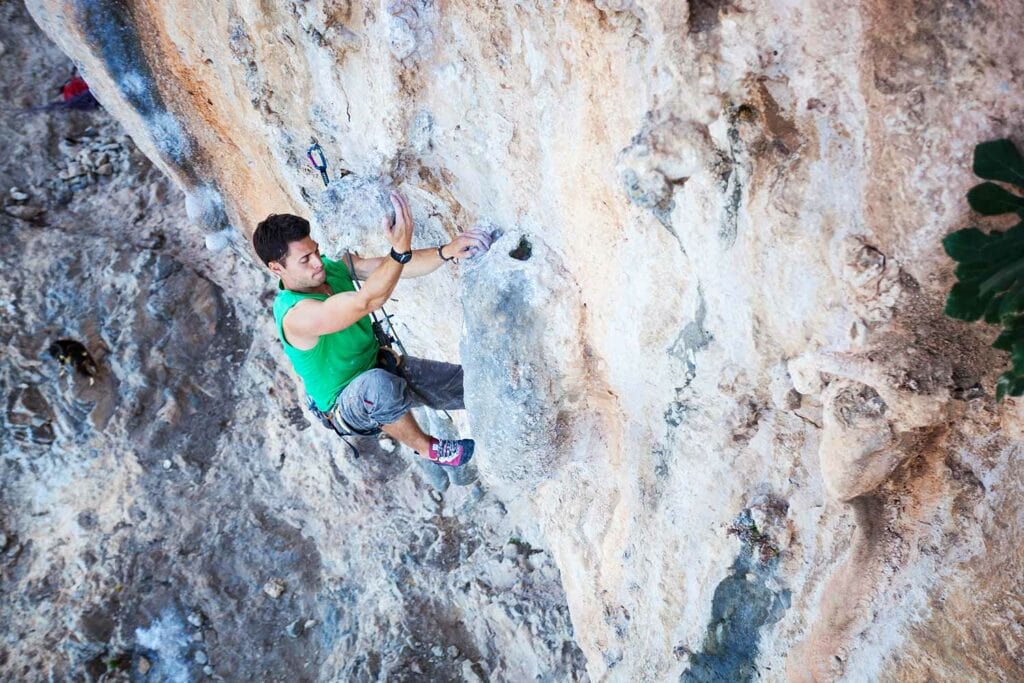
Your age, gender, daily activity, weight, and body composition are some factors that affect your caloric burn. The more energy you expend, the more you’ll burn.
To calculate calories burned, you’ll need to do a little math. First, calculate your Basal Metabolic Rate, or BMR, using the Harris-Benedict formula. Weight is in pounds, and we use inches for height.
Basal Metabolic Rate
Men BMR = 66 + (6.2 x weight) + (12.7 x height) – (6.76 x age)
Women BMR = 655.1 + (4.35 x weight) + (4.7 x height) – (4.7 x age)
After calculating your BMR, choose your Activity Level Number, or ALN, depending on the amount of physical activity you do weekly:
- 1.2 – sedentary or little to no physical activity
- 1.37 – light exercise 1-3 days a week
- 1.55 – moderate exercises 3-5 days a week
- 1.725 – very active, intense exercise 6-7 days a week
- 1.9 – extra active, very intense exercise, or a demanding physical job
Your daily calories burned = BMR x ALN
You can also use an online calculator to calculate this formula or ask your doctor or nutritionist if you want to make sure you have the most accurate data.
MET Value

Your MET, or Metabolic Equivalent, value measures the energy expenditure while sitting sedentary and is gauged by the hour. A MET is the energy your body expends while at rest.
Measure your MET values by calculating your weight in kilograms or 1kcal/kg/hour. A 180 lb (81.6 kg) male has a MET value of 81.6, burning about 81.6 calories per hour while sedentary.
Each activity you do has its MET value. 1 corresponds to a person at rest, sitting or lying down, and not actively digesting food. An activity with a MET value of 3 means exerting three times the amount of energy you would if you were resting.
To calculate the number of calories per hour burned while doing a particular activity, take the MET value of an activity and multiply it by your weight in kilograms.
Below is a list of MET values for basic physical activities:
| Physical activity | Metabolic Equivalent (MET) |
|---|---|
| Walking | 2 |
| Running | 9 |
| Cycling | 7.5 |
| Resistance Weight Training | 3.5 |
| Stationary Rowing | 6 |
| Yoga | 2.5 |
Keep in mind that this method does not take into account your age, gender, body composition, and other factors. This number is just an estimation.
MET value for climbing
According to the Compendium of Physical Activities (2011), the MET for rock climbing ranges between 5 and 7.5 depending on the level of effort, with 7.5 corresponding to ascending a strenuous route.
Continue reading to find out the factors that influence this value.
Rock Climbing as a Fitness Exercise
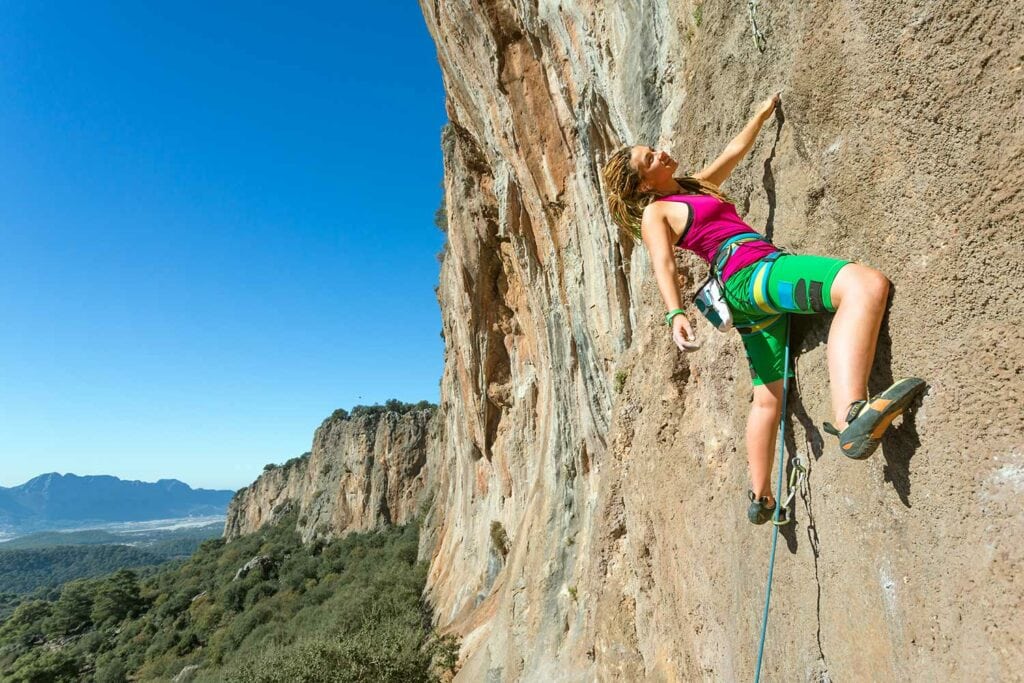
Climbing is a great way to add physical activity and burn serious calories. The sport of climbing is dynamic. It includes aerobic and anaerobic activities with exercise stopping and starting. This makes it a bit harder to measure true caloric burn accurately. How long you spend climbing, the intensity, speed, and difficulty level will determine the number of calories you burn.
Parameters to Consider
Duration
The duration of your exercise activity, whether climbing, running, or biking, will always influence the number of calories burned. The longer you actively climb, the higher your heart rate and caloric burn will be.
It’s also important to point out that a one-hour session of intense climbing compared to a three-hour session at a lower skill level may burn around the same number of calories. Timing matters but so does the intensity.
Intensity & Speed
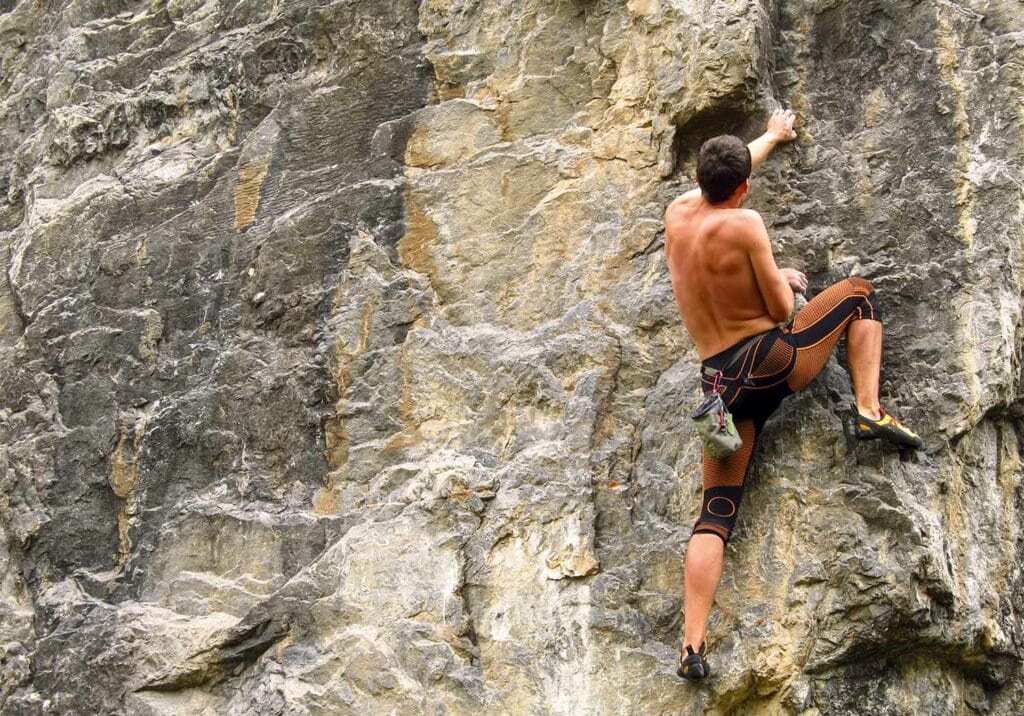
Climbing is an excellent workout for your entire body, and this activity will likely stimulate different muscle groups at once. When working several muscle groups, your body naturally expends more energy.
According to research, the best exercises for caloric burn use various muscle groups and are high-intensity with continuous movement. Climbers find that carrying extra weight using a weighted vest can increase the intensity even more. Both intensity and speed can influence the energy cost of your chosen climbing workout.
Route Grade
Each route is graded for its difficulty. If you choose only to climb 5.5 routes and never push yourself to try anything of high difficulty, you’re chance of engaging in an activity that accurately burns calories is low.
To add good cardio to your climbing session, climb a lower-graded route consistently for 15 to 20 minutes. Make sure that you’re not feeling a burning sensation in your forearms. If this happens, it changes the workout from aerobic to anaerobic, and you will fatigue quickly. For this type of exercise, limit your rest time to keep your heart rate elevated.
Differences Per Type of Climbing
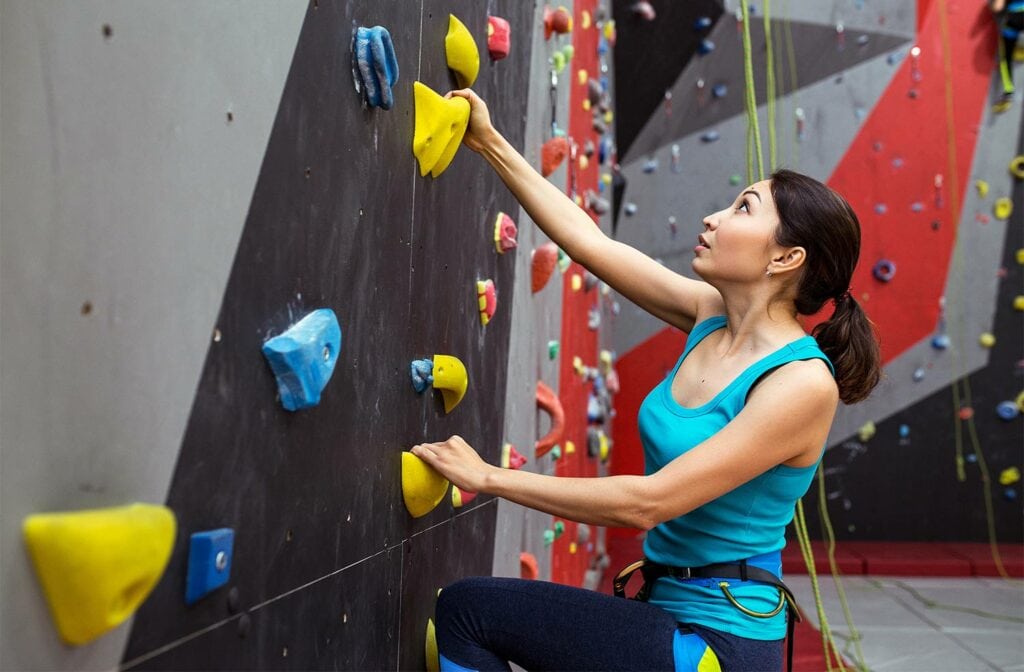
Bouldering
Bouldering is a combination of dynamic and static movements at a shorter height. Although bouldering requires a good amount of physical effort, bouldering routes don’t give you the consistency that top rope climbing does.
Traversing rock for more extended periods, on the other hand, requires more effort, and you will spend a longer time climbing. Work on less challenging problems without resting to raise your heart rate and add other exercises between climbs. The more time you spend moving, the longer your heart rate will stay elevated, which increases your caloric expenditure.
Trad Climbing
Traditional rock climbing (or trad climbing) is one of the best exercises to stay fit and gain more muscle. These routes involve consistently moving, shifting your body weight, and working your muscles.
Trad also requires using specific trad gear, which must be carried on your harness while climbing. The more weight you carry, the more calories you burn. This sport also forces you to use your brain; it’s similar to a puzzle. Because of this, you spend more time climbing, making trad climbing a great exercise.
Sport Climbing
Sport climbing follows bolts up a pre-planned route. Although you’re likely not carrying much gear, sport climbing involves constant movement and physical strategy. This affects how many calories you burn—it can be a heavy workout! With this type of climbing, you can choose the right difficulty level for you and have more control over how long you spend on the wall.
Calories Burned Rock Climbing

So how many calories do you burn rock climbing? On average, rock climbing burns anywhere from 400 to 600 Calories per hour. The total calories burned will depend on the duration of your workout, the kind of climbing, and the intensity and route grade.
Indeed, research suggests that the average person will expend about 8 to 11 kilocalories a minute when actively climbing a rock wall. That equates to up to 660 Calories burned per hour! Remember that this only includes the time you are actually climbing and does not include rest time. Also, it’s an indicative range: some climbers may fall below or beyond it, depending on their effort.
Wearing a heart monitor and timing your climbing sessions can help you better understand how many calories you burn per hour. To raise your caloric burn, keep your heart rate elevated, add extra weight to your next workout, spend more time actively climbing, and monitor your personal fitness progress. Work several muscle groups in the same session, and don’t forget to increase the difficulty level. If you want to focus on cardio, I suggest low-to-moderate-difficulty-level routes.
Frequently Asked Questions (FAQs)
Climbing can be an awesome cardio workout. Work on less challenging problems or routes without resting to increase the cardio during your climbing session. This will keep your heart rate elevated and your body burning calories.
You can lose weight while rock climbing, like any other sport requiring movement and energy exertion. To reduce your weight with rock climbing, increase your sessions’ intensity and duration. Wear a weighted vest, try a harder route grade, and spend more time moving than resting.
Yes, you do burn calories while belaying. The MET value for standing is 1.6. While belaying, you are still moving, so an estimated MET for belaying could be around a 3. Multiply the MET value for belaying by your weight in kilograms to estimate how many calories you burn per hour.
Rock climbing can be a fun, calorie-burning workout if you want it to be. It all depends on the difficulty level, your heart rate range, and your chosen climbing session duration. The number of calories burned is also determined by factors like age, gender, body composition, daily activity, and metabolism. So get out to the rock wall, and see how many calories you can burn!

Calculation is incorrect;
Research suggests that the average person will expend about 8 to 11 kilocalories a minute when actively climbing a rock wall. That would equate to nearly 600 Calories burned per hour!
Either 8-11 calories or 600KCal per hour.